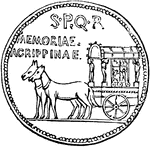Clipart tagged: ‘Carra’

Carpentum
"A cart; also a two-wheeled carriage enclosed, and with an arched or sloping cover overhead. The carpentum…

"A cart; also a two-wheeled carriage enclosed, and with an arched or sloping cover overhead. The carpentum…